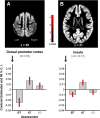Brain changes associated with postural training in patients with cerebellar degeneration: a voxel-based morphometry study
- PMID: 23467375
- PMCID: PMC6704968
- DOI: 10.1523/JNEUROSCI.3381-12.2013
Brain changes associated with postural training in patients with cerebellar degeneration: a voxel-based morphometry study
Abstract
Recent research indicates that physiotherapy can improve motor performance of patients with cerebellar degeneration. Given the known contributions of the cerebellum to motor learning, it remains unclear whether such observable changes in performance are mediated by the cerebellum or cerebral brain areas involved in motor control and learning. The current study addressed this question by assessing the increase in gray matter volume due to sensorimotor training in cerebellar patients using voxel-based morphometry. Nineteen human subjects with pure cerebellar degeneration and matched healthy controls were trained for 2 weeks on a balance task. Postural and clinical assessments along with structural magnetic resonance imaging were performed pretraining and post-training. The main findings were as follows. First, training enhanced balance performance in cerebellar patients. Second, in contrast to controls patients revealed significantly more post-training gray matter volume in the dorsal premotor cortex. Third, training-related increase in gray matter volume was observed within the cerebellum and was more pronounced in controls than in patients. However, statistically cerebellar changes were at the trend level and thus require additional, independent confirmation. We conclude that sensorimotor training of patients with cerebellar neurodegeneration induces gray matter changes primarily within nonaffected neocortical regions of the cerebellar-cortical loop. Residual function of the cerebellum appears to be exploited suggesting either a recovery from degeneration or intact processes of cerebellar plasticity in the remaining healthy tissue.
Figures








References
-
- Anheim M, Tranchant C, Koenig M. The autosomal recessive cerebellar ataxias. N Engl J Med. 2012;366:636–646. - PubMed
-
- Ashburner J, Friston KJ. Unified segmentation. Neuroimage. 2005;26:839–851. - PubMed
-
- Beauchamp MS, Lee KE, Haxby JV, Martin A. Parallel visual motion processing streams for manipulable objects and human movements. Neuron. 2002;34:149–159. - PubMed
-
- Beauchamp MS, Lee KE, Haxby JV, Martin A. FMRI responses to video and point-light displays of moving humans and manipulable objects. J Cogn Neurosci. 2003;15:991–1001. - PubMed
Publication types
MeSH terms
LinkOut - more resources
Full Text Sources
Other Literature Sources
Medical
